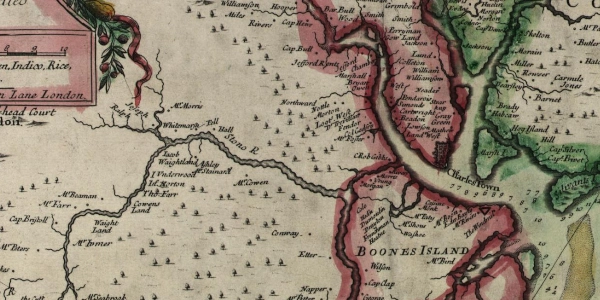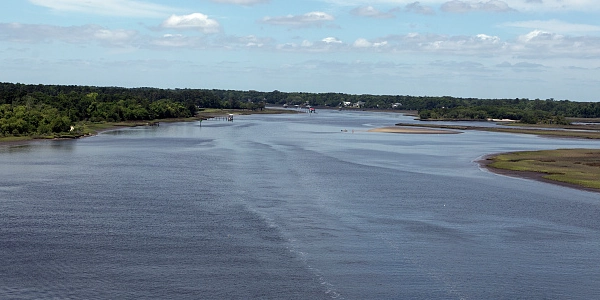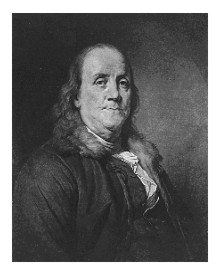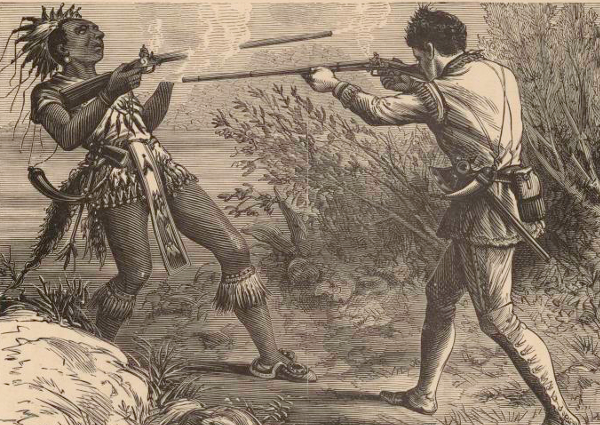Sponsor this page. Your banner or text ad can fill the space above.
Click here to Sponsor the page and how to reserve your ad.
-
Timeline
1739 Detail
September 9, 1739 - The last major slave rebellion in the mainland colonies of English, the Stono Rebellion, begins in South Carolina.

It would be the largest slave rebellion in the English colonies prior to the American Revolution, which, is rather hard to believe considering slavery had been introduced into the Colony of Virginia in 1619. The Stono River ran west of Charleston, South Carolina. A smallpox epidemic had decimated the area in 1738 and this year yellow fever were spreading. Before daylight on the morning of September 9, twenty enslaved Carolinians on a work crew led by an Angolan named Jemmy met at the Stono River in St. Paul's Parish, twenty miles west of Charleston. They approached the Stono Bridge near Hutchinson's store. They took guns and ammunition from the store. They killed the two storekeepers. They were not done with the killing. At the house of Mr. Godfrey, they killed him, his son, and daughter. At Wallace's Tavern where the innkeeper had always been kind to his slaves, his life was spared. At the next half dozen or so homes, whether wealthy planters or poor farmers, the inhabitants were murdered.
As they headed south, they called out "Liberty" with the intention of reaching St. Augustine, which was still controlled by Spain. Spain had, in part, prompted the rebellion by agreeing to give any English colonial slave land and freedom if they made it to Florida. Seventy slaves had previously taken advantage of that. But it was a long walk. The August passage of the Security Act had also stirred up the passion to rebel. White men had been ordered to carry firearms to church beginning on September 29, 1739, or be subject to a fine.
They gathered additional slaves as they moved south, their number now rising to fifty, some contend one hundred. The killing was not done yet. One man, however, Lt. Governor Bull and a few of his friends had eluded the rebelling slaves and sounded the alarm. Their warming quickly raised a militia of twenty to one hundred men on horseback to catch up with the insurgent slaves. The slaves stopped at the Edisto River late in the afternoon after a ten mile walk and killing spree of twenty to twenty-five white men and women.
Upon approaching the rebels, the slaves fired two shots toward the militia. The militia returned fire, knocking down fourteen of the slaves. A total of twenty of the militia were killed; up to forty of the rebellious slaves were gone by the time the rebellion halted that day, and over the ensueing months the remainder were captured by whites and Indians hired for the task. Only one member of the slave rebellion escaped capture, for three years.
There would be consequences, harsher slave codes were enacted in the Carolinas. The Negro Act banned slaves from growing food, assemble as a group, learn to read, buy alcohol, or make money. A ban on slave imports was also enacted, along with no work on Sundays, a ban on murdering slaves, and the masters had to provide adequate food and clothing, in an effort to reduce the likelihood of additional rebellions.
Slave Insurrection in the Colonies
Although there had always been slave revolts in the English, Spanish, and French colonies of North America and the Caribbean, it was not until 1780 that the problem, particularly now with England in sharp control of most of the colonial efforts on the mainland, increased. Between that date and 1864, there were over two hundred and fifty documented cases of slave rebellions. Just in the Colony of Virginia, ninety-one black slaves were convicted of the offense.
Some of the most ambitious were Gabriel's Revolt on August 30, 1800 near Richmond, when slave Gabriel rallied one thousand armed slaves, but were stopped by a strong storm. Gabriel and thirty-four others were hanged as a result. Vessey's Rebellion in 1822 was a conspiracy to incite nine thousand outside Charleston, but the conspiracy was found out before the plan could be enacted. One hundred and thirty-five were arrested, thirty-five hanged, including Vessey, and thirty-two exiled. Nat Turner's rebellion in 1831 killed sixty white people as they approached an armory in Jeruselum, Southhampton County, Virginia. All seventy-five insurgents were killed or captured; Turner was hanged.

Reports of the Stono Rebellion
Lt. Governor William Bull
My Lords,
I beg leave to lay before your Lordships an account of our Affairs, first in regard to the Desertion of our Negroes. . . . On the 9th of September last at Night a great Number of Negroes Arose in Rebellion, broke open a Store where they got arms, killed twenty one White Persons, and were marching the next morning in a Daring manner out of the Province, killing all they met and burning several Houses as they passed along the Road. I was returning from Granville County with four Gentlemen and met these Rebels at eleven o'clock in the forenoon and fortunately deserned the approaching danger time enough to avoid it, and to give notice to the Militia who on the Occasion behaved with so much expedition and bravery, as by four a'Clock the same day to come up with them and killed and took so many as put a stop to any further mischief at that time, forty four of them have been killed and Executed; some few yet remain concealed in the Woods expecting the same fate, seem desperate.
It was the Opinion of His Majesty's Council with several other Gentlemen that one of the most effectual means that could be used at present to prevent such desertion of our Negroes is to encourage some Indians by a suitable reward to pursue and if possible to bring back the Deserters, and while the Indians are thus employed they would be in the way ready to intercept others that might attempt to follow and I have sent for the Chiefs of the Chickasaws living at New Windsor and the Catawbaw Indians for that purpose.
My Lords,
Your Lordships Most Obedient and Most Humble Servant
Wm Bull
Stono Slave-Catchers Report
A Commons House of Assembly Committee Report, in a Message to the Governor's Council
November 29, 1739
1. That upon Inquiry your Committee find that a negro man named July belonging to Mr. Thomas Elliott was very early and chiefly instrumental in saving his Master and his Family from being destroyed by the Rebellious Negroes and that the Negro man July had at several times bravely fought against the Rebels and killed one of them. Your Committee therefore recommends that the [said] Negro July (as a reward for his faithful Services and for na Encouragement to other Slaves to follow his Example in case of the like Nature) shall have his Freedom and a Present of a Suit of Cloaths, Shirt, Hat, a pair of stockings and a pair of Shoes.
2. That the several Slaves heareafter named Ralph, Prince, Joe, Larush and Pompey belonging to the [said] Mr Thos Elliott, Sampon belonging to to Mr Wilkinson, two Negro Men and a Negro Woman (whose names your Committee do not know) belonging to Mr Thomas Rose, Two Negro Men (whose names are also unkown to your Committee) who belong to the Estate of Mr John Haynes decd. And one Negro Man (his name not known by your Committee) belonging to the Estate of Mr Christopher Wilkinson decd a Negro man belonging to Mrs Wilkson Widow named Mingo; a Mustee Man have behaved themselves very well and been a great source in opposing the Rebellions Negroes; For which your Committee recommend that they be rewarded as follows (that is to say) the Men to have each a Suit of Cloths, hat, shirt, a pair of Shoes, and a pair of Stockings, And the Women to have each a Jacket and Petticoat, a Shift, a pair of Stockings, and a pair of Shoes and also the sum of 20[lb] in Cash to each of the Slaves above named.
7. That several of the Neighbouring Indians did assist in hunting for, taking and destroying the [said] Rebellious Negroes, For which your Committee propose that the [said] Indians be severally rewarded with a Coat, a Flap, a Hat, a pair of Indian Stockings, a Gun, 2 pounds of Powder and 8 Pounds of Bullets, Which Indians Names are as follows (that is to say) Tobb, Old Jack, Peter, Tom and Philip and five other Indians (whose names your Committee do not know) that came down to Stono with Captain Coachman.
Image above: Detailed map showing Stono River in the province of Carolina, 1711, Edward Crisp. Courtesy Library of Congress. Image Below: Stono River west of Charleston, South Carolina, 2017, Carol M. Highsmith. Courtesy Library of Congress. Info Source: Library of Congress; "Africans in America, the Stono Rebellion," PBS; Bill of Rights Institute; Britannica.com; Wikipedia Commons.

History Photo Bomb

It would be the largest slave rebellion in the English colonies prior to the American Revolution, which, is rather hard to believe considering slavery had been introduced into the Colony of Virginia in 1619. The Stono River ran west of Charleston, South Carolina. A smallpox epidemic had decimated the area in 1738 and this year yellow fever were spreading. Before daylight on the morning of September 9, twenty enslaved Carolinians on a work crew led by an Angolan named Jemmy met at the Stono River in St. Paul's Parish, twenty miles west of Charleston. They approached the Stono Bridge near Hutchinson's store. They took guns and ammunition from the store. They killed the two storekeepers. They were not done with the killing. At the house of Mr. Godfrey, they killed him, his son, and daughter. At Wallace's Tavern where the innkeeper had always been kind to his slaves, his life was spared. At the next half dozen or so homes, whether wealthy planters or poor farmers, the inhabitants were murdered.
As they headed south, they called out "Liberty" with the intention of reaching St. Augustine, which was still controlled by Spain. Spain had, in part, prompted the rebellion by agreeing to give any English colonial slave land and freedom if they made it to Florida. Seventy slaves had previously taken advantage of that. But it was a long walk. The August passage of the Security Act had also stirred up the passion to rebel. White men had been ordered to carry firearms to church beginning on September 29, 1739, or be subject to a fine.
They gathered additional slaves as they moved south, their number now rising to fifty, some contend one hundred. The killing was not done yet. One man, however, Lt. Governor Bull and a few of his friends had eluded the rebelling slaves and sounded the alarm. Their warming quickly raised a militia of twenty to one hundred men on horseback to catch up with the insurgent slaves. The slaves stopped at the Edisto River late in the afternoon after a ten mile walk and killing spree of twenty to twenty-five white men and women.
Upon approaching the rebels, the slaves fired two shots toward the militia. The militia returned fire, knocking down fourteen of the slaves. A total of twenty of the militia were killed; up to forty of the rebellious slaves were gone by the time the rebellion halted that day, and over the ensueing months the remainder were captured by whites and Indians hired for the task. Only one member of the slave rebellion escaped capture, for three years.
There would be consequences, harsher slave codes were enacted in the Carolinas. The Negro Act banned slaves from growing food, assemble as a group, learn to read, buy alcohol, or make money. A ban on slave imports was also enacted, along with no work on Sundays, a ban on murdering slaves, and the masters had to provide adequate food and clothing, in an effort to reduce the likelihood of additional rebellions.
Slave Insurrection in the Colonies
Although there had always been slave revolts in the English, Spanish, and French colonies of North America and the Caribbean, it was not until 1780 that the problem, particularly now with England in sharp control of most of the colonial efforts on the mainland, increased. Between that date and 1864, there were over two hundred and fifty documented cases of slave rebellions. Just in the Colony of Virginia, ninety-one black slaves were convicted of the offense.
Some of the most ambitious were Gabriel's Revolt on August 30, 1800 near Richmond, when slave Gabriel rallied one thousand armed slaves, but were stopped by a strong storm. Gabriel and thirty-four others were hanged as a result. Vessey's Rebellion in 1822 was a conspiracy to incite nine thousand outside Charleston, but the conspiracy was found out before the plan could be enacted. One hundred and thirty-five were arrested, thirty-five hanged, including Vessey, and thirty-two exiled. Nat Turner's rebellion in 1831 killed sixty white people as they approached an armory in Jeruselum, Southhampton County, Virginia. All seventy-five insurgents were killed or captured; Turner was hanged.

Reports of the Stono Rebellion
Lt. Governor William Bull
My Lords,
I beg leave to lay before your Lordships an account of our Affairs, first in regard to the Desertion of our Negroes. . . . On the 9th of September last at Night a great Number of Negroes Arose in Rebellion, broke open a Store where they got arms, killed twenty one White Persons, and were marching the next morning in a Daring manner out of the Province, killing all they met and burning several Houses as they passed along the Road. I was returning from Granville County with four Gentlemen and met these Rebels at eleven o'clock in the forenoon and fortunately deserned the approaching danger time enough to avoid it, and to give notice to the Militia who on the Occasion behaved with so much expedition and bravery, as by four a'Clock the same day to come up with them and killed and took so many as put a stop to any further mischief at that time, forty four of them have been killed and Executed; some few yet remain concealed in the Woods expecting the same fate, seem desperate.
It was the Opinion of His Majesty's Council with several other Gentlemen that one of the most effectual means that could be used at present to prevent such desertion of our Negroes is to encourage some Indians by a suitable reward to pursue and if possible to bring back the Deserters, and while the Indians are thus employed they would be in the way ready to intercept others that might attempt to follow and I have sent for the Chiefs of the Chickasaws living at New Windsor and the Catawbaw Indians for that purpose.
My Lords,
Your Lordships Most Obedient and Most Humble Servant
Wm Bull
Stono Slave-Catchers Report
A Commons House of Assembly Committee Report, in a Message to the Governor's Council
November 29, 1739
1. That upon Inquiry your Committee find that a negro man named July belonging to Mr. Thomas Elliott was very early and chiefly instrumental in saving his Master and his Family from being destroyed by the Rebellious Negroes and that the Negro man July had at several times bravely fought against the Rebels and killed one of them. Your Committee therefore recommends that the [said] Negro July (as a reward for his faithful Services and for na Encouragement to other Slaves to follow his Example in case of the like Nature) shall have his Freedom and a Present of a Suit of Cloaths, Shirt, Hat, a pair of stockings and a pair of Shoes.
2. That the several Slaves heareafter named Ralph, Prince, Joe, Larush and Pompey belonging to the [said] Mr Thos Elliott, Sampon belonging to to Mr Wilkinson, two Negro Men and a Negro Woman (whose names your Committee do not know) belonging to Mr Thomas Rose, Two Negro Men (whose names are also unkown to your Committee) who belong to the Estate of Mr John Haynes decd. And one Negro Man (his name not known by your Committee) belonging to the Estate of Mr Christopher Wilkinson decd a Negro man belonging to Mrs Wilkson Widow named Mingo; a Mustee Man have behaved themselves very well and been a great source in opposing the Rebellions Negroes; For which your Committee recommend that they be rewarded as follows (that is to say) the Men to have each a Suit of Cloths, hat, shirt, a pair of Shoes, and a pair of Stockings, And the Women to have each a Jacket and Petticoat, a Shift, a pair of Stockings, and a pair of Shoes and also the sum of 20[lb] in Cash to each of the Slaves above named.
7. That several of the Neighbouring Indians did assist in hunting for, taking and destroying the [said] Rebellious Negroes, For which your Committee propose that the [said] Indians be severally rewarded with a Coat, a Flap, a Hat, a pair of Indian Stockings, a Gun, 2 pounds of Powder and 8 Pounds of Bullets, Which Indians Names are as follows (that is to say) Tobb, Old Jack, Peter, Tom and Philip and five other Indians (whose names your Committee do not know) that came down to Stono with Captain Coachman.
Image above: Detailed map showing Stono River in the province of Carolina, 1711, Edward Crisp. Courtesy Library of Congress. Image Below: Stono River west of Charleston, South Carolina, 2017, Carol M. Highsmith. Courtesy Library of Congress. Info Source: Library of Congress; "Africans in America, the Stono Rebellion," PBS; Bill of Rights Institute; Britannica.com; Wikipedia Commons.





